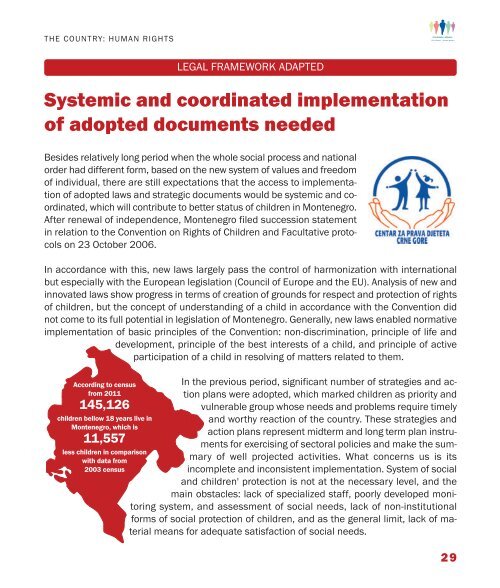Insight view
CA-10-years-of-independence-insight-view
CA-10-years-of-independence-insight-view
Create successful ePaper yourself
Turn your PDF publications into a flip-book with our unique Google optimized e-Paper software.
THE COUNTRY: HUMAN RIGHTS<br />
LEGAL FRAMEWORK ADAPTED<br />
Systemic and coordinated implementation<br />
of adopted documents needed<br />
Besides relatively long period when the whole social process and national<br />
order had different form, based on the new system of values and freedom<br />
of individual, there are still expectations that the access to implementation<br />
of adopted laws and strategic documents would be systemic and coordinated,<br />
which will contribute to better status of children in Montenegro.<br />
After renewal of independence, Montenegro filed succession statement<br />
in relation to the Convention on Rights of Children and Facultative protocols<br />
on 23 October 2006.<br />
In accordance with this, new laws largely pass the control of harmonization with international<br />
but especially with the European legislation (Council of Europe and the EU). Analysis of new and<br />
innovated laws show progress in terms of creation of grounds for respect and protection of rights<br />
of children, but the concept of understanding of a child in accordance with the Convention did<br />
not come to its full potential in legislation of Montenegro. Generally, new laws enabled normative<br />
implementation of basic principles of the Convention: non-discrimination, principle of life and<br />
development, principle of the best interests of a child, and principle of active<br />
participation of a child in resolving of matters related to them.<br />
According to census<br />
from 2011<br />
145,126<br />
children bellow 18 years live in<br />
Montenegro, which is<br />
11,557<br />
less children in comparison<br />
with data from<br />
2003 census<br />
Tivat<br />
In the previous period, significant number of strategies and action<br />
plans were adopted, which marked children as priority and<br />
vulnerable group whose needs and problems require timely<br />
and worthy reaction of the country. These strategies and<br />
action plans represent midterm and long term plan instruments<br />
for exercising of sectoral policies and make the summary<br />
of well projected activities. What concerns us is its<br />
incomplete and inconsistent implementation. System of social<br />
and children' protection is not at the necessary level, and the<br />
main obstacles: lack of specialized staff, poorly developed monitoring<br />
system, and assessment of social needs, lack of non-institutional<br />
forms of social protection of children, and as the general limit, lack of material<br />
means for adequate satisfaction of social needs.<br />
29


